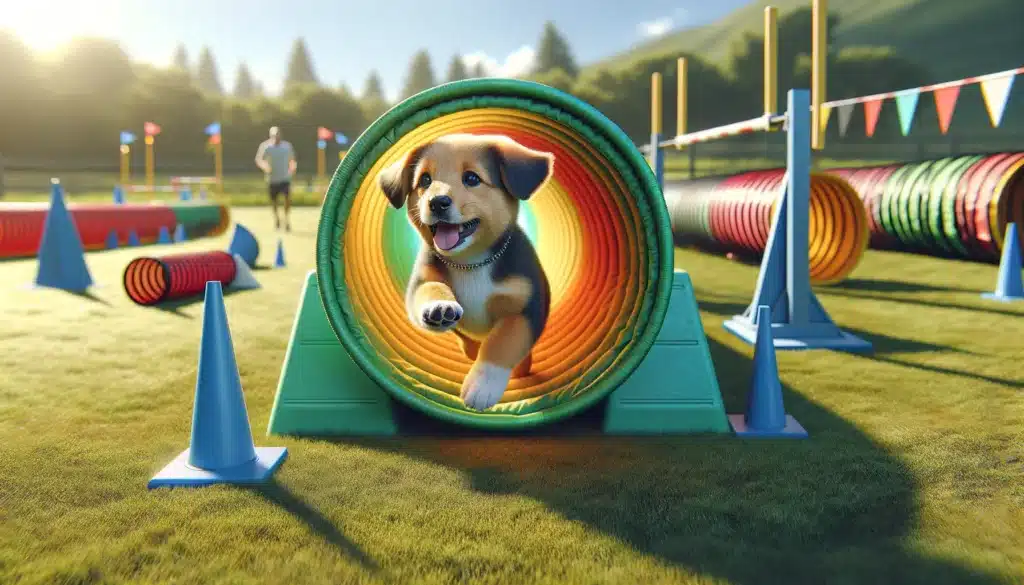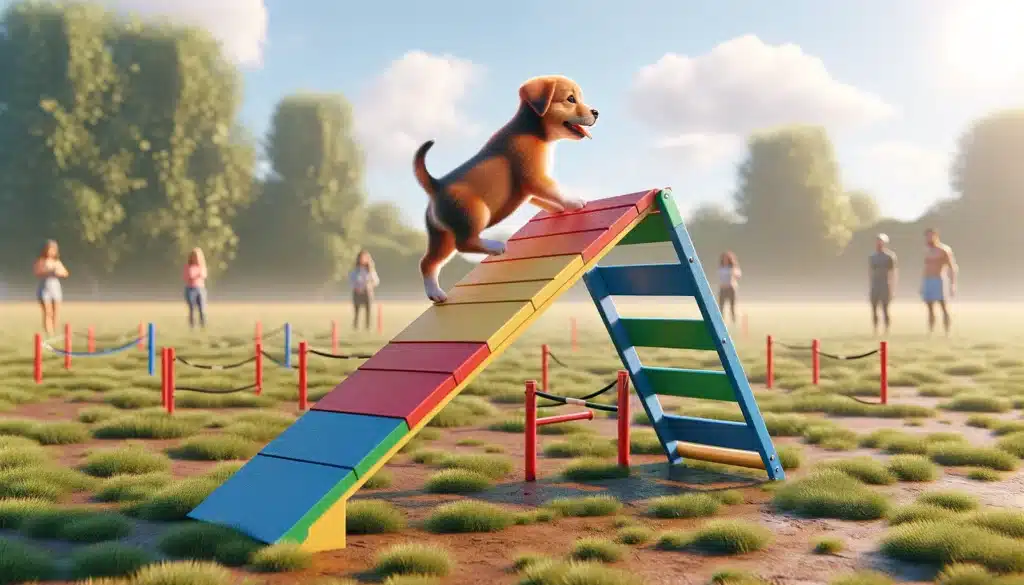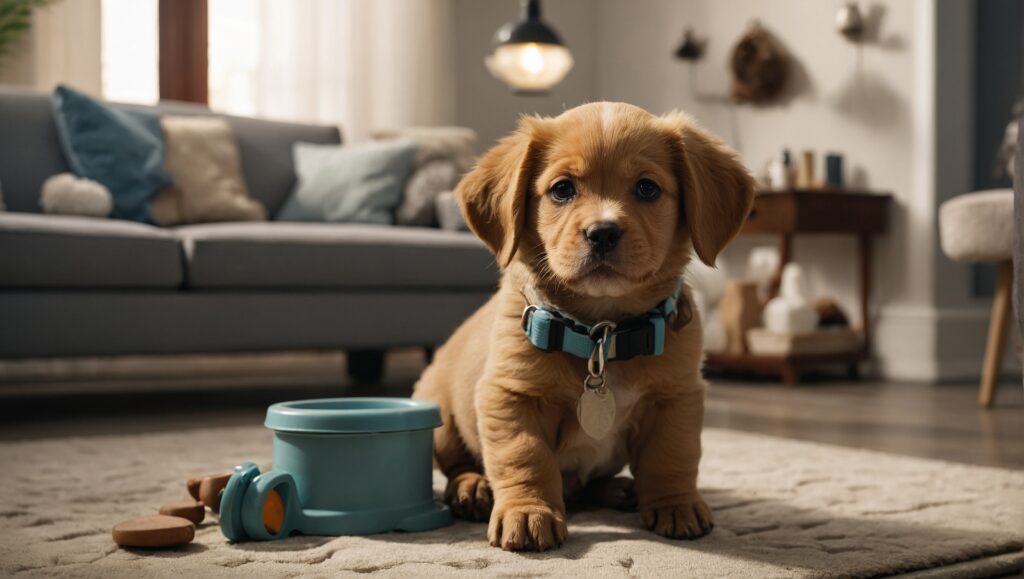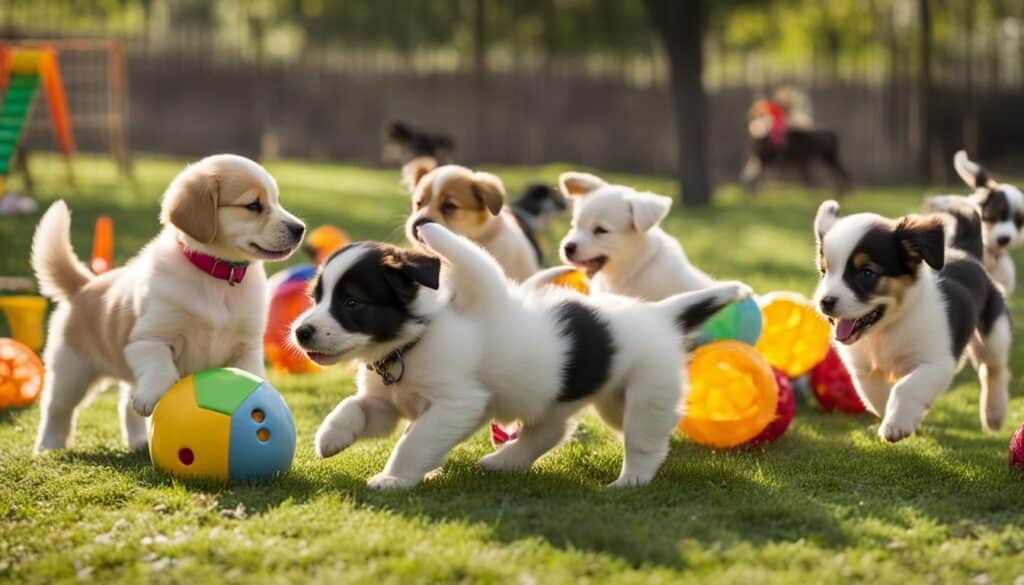Puppy Agility training isn’t just for those sleek puppies you see on TV! Puppies of all shapes, sizes, and breeds can benefit tremendously from this exciting activity. Puppy agility training is all about guiding your furry friend through obstacles like tunnels, jumps, and weave poles. It might look like all fun and games, but agility training offers abundant valuable benefits for your growing pup.
First, it’s a fantastic way to keep your puppy fit and active. Pups have boundless energy, and agility provides a structured way to help them burn it off. Secondly, agility challenges your puppy mentally, boosting problem-solving skills and sharpening focus. Perhaps most importantly, puppy agility training is a confidence booster. As your puppy conquers each obstacle, they build a sense of accomplishment that translates into a happy, well-adjusted dog; on top of all that, the teamwork strengthens the bond between you and your furry companion.
In this blog post, we’ll delve into puppy agility training, exploring the benefits, how to get started, and everything you need to transform your pup into a confident and agile superstar.

Key Takeaways
- Puppy agility training is a fantastic way to boost your dog’s physical fitness and mental well-being.
- Agility promotes confidence and problem-solving skills and strengthens your bond with furry friends.
- Positive reinforcement, patience, and starting with simple obstacles are essential for success.
- Every puppy can benefit from agility training, regardless of age, breed, or size.
- Agility training should always be safe, enjoyable, and tailored to your puppy’s needs.
Why Puppy Agility Training?
Suppose you’re looking for a way to enhance your puppy’s life in multiple ways; puppy agility training ticks all the boxes. Here’s a breakdown of the primary benefits:
- Physical Fitness: Agility training is a full-body workout for your pup. Running, jumping, and weaving build muscle, improve coordination, and contribute to a healthy weight. It’s a great way to combat puppy obesity and ensure your dog develops a muscular, athletic physique.
- Mental Stimulation: Agility is like solving puzzles for dogs. Learning to navigate obstacles keeps their minds engaged, preventing boredom and destructive behaviors. It also teaches focus and improves their ability to follow your cues.
- Confidence Building: The feeling of accomplishment a puppy gets from mastering a new obstacle is priceless. Overcoming challenges builds resilience and a “can-do” attitude that benefits them in all areas of life.
- Bonding: Puppy agility training is a team effort. Working together, guiding your puppy, and celebrating their successes strengthens your bond and builds trust. It’s a fantastic way to solidify your partnership.
- Fun Factor: Let’s be honest; puppies are born to play! Agility training taps into that natural playfulness, providing endless fun and excitement. A tired puppy is often a happy and well-behaved puppy.
Getting Started with Puppy Agility
Embarking on your puppy’s agility journey is exciting, but starting with the right mindset and preparation is crucial to ensure a positive and safe experience. Here’s a more in-depth look at the things to consider:
- Age Considerations: While most puppies can safely start essential agility around 8-12 weeks old, it’s always recommended to consult your veterinarian for the green light. They’ll assess your puppy’s growth plates and overall development to ensure their young joints are ready for the activity.
- Essential Equipment: You don’t need a complete agility course to get started. Simple obstacles provide a great foundation. Tunnels can be created with a child’s play tunnel or a large cardboard box. Low jumps can be set up with a broom handle over sturdy objects like books or cinderblocks. Weave poles can be simulated with spaced-out cones or even empty water bottles. There are also beginner agility kits available that offer adjustable equipment perfect for growing puppies.
- Finding Classes: Puppy agility classes offer the most structured learning environment with the guidance of a qualified instructor. Trainers ensure the safe introduction of obstacles, focus on proper techniques for you and your puppy, and prioritize overall safety. Ensure you find classes tailored explicitly to puppies and their developmental needs.
- At-Home Training: You can start training at home, even if you decide to enroll in classes later on. Numerous online resources, tutorials, and videos can guide you through introducing obstacles and teaching basic commands. Dedication and consistency are crucial to success when training at home, as it’s essential to have regular, structured practice sessions.
Puppy Agility Training Basics
Starting your puppy on the right paw sets the foundation for successful agility training. Here’s what you need to keep in mind:
- Positive Reinforcement is Key: Training should always be fun! Puppies thrive on positive reinforcement – use plenty of treats, toys, and enthusiastic praise to reward even the most minor attempts at obstacles. This makes learning enjoyable and encourages eagerness.
- Short and Sweet Sessions: Puppies have short attention spans and tire quickly. Aim for multiple short sessions of 5-10 minutes throughout the day rather than one long training block.
- Start Simple: Begin with obstacles at the lowest levels or on the ground. Let your puppy explore and sniff out the equipment, rewarding any curiosity. Focus on building enthusiasm for the obstacles themselves.
- Gradual Progression: As your puppy gains confidence, you can gradually increase the difficulty level by raising jump heights, adjusting weave pole spacing, or introducing more complex elements. Patience is vital – let your puppy master each skill before moving on.
- Safety First: Always prioritize safety. Warm up your puppy with playtime or light exercise and stretch those muscles. Check the equipment for stability and the training area for hazards. Know your puppy’s limits and allow them to rest when needed.
Puppy Agility Training Obstacles
Agility courses are filled with various obstacles designed to challenge your puppy’s physical coordination and problem-solving skills. Here’s a closer look at some of the most common ones:

- Tunnels: Tunnels are a blast for dogs and come in different forms. Straight tunnels are a fantastic introduction, while collapsible tunnels add a fun element of surprise. Start by encouraging your puppy to explore short tunnels with treats or toys, gradually increasing the length or adding gentle curves.
- Jumps: Jumping is natural for dogs, but proper form is essential to prevent injury. Start with a single bar on the ground, then gradually raise it as your puppy masters each height. Focus on rewarding them for clean jumps over the center of the bar rather than speed. Agility kits often include panel or tire jumps, which offer variety and added challenges.
- Weave Poles: Weave poles develop fantastic coordination and body awareness. Start by setting the poles far apart and guide your puppy through with a treat. Gradually decrease the spacing as their weaving skills improve. You can run alongside them for extra motivation, encouraging them through the poles until they develop independent mastery.
- A-frames and Contact Obstacles: A-frames, teeter-totters, and dog walks are contact obstacles that require focus and confidence. Introduce them slowly, focusing on positive associations. Allow your puppy to investigate at their own pace. Use plenty of treats and guide them across the lowered obstacle, rewarding each step. Ensure proper ramp-up/ramp-down techniques to prevent injury.
Every puppy learns at their own pace. While some will be eager to tackle any obstacle, others might be more hesitant. Patience and positive reinforcement will help timid pups feel more secure and gain the confidence.

Troubleshooting Puppy Agility
It’s normal to encounter a few bumps on your agility road. Here’s how to handle some of the most common puppy training obstacles:
- Refusal: If your puppy refuses an obstacle, don’t force them or get discouraged. Step back and make it easier – lower the jump, widen the weave poles, or shorten the tunnel. Add a high-value lure to spark interest, like a favorite toy or a yummy treat. Revisit the obstacle later with a fresh and positive approach.
- Overexcitement: Some puppies get too revved up, becoming distracted and unfocused. If excitement is derailing training, take short breaks to calm their energy. Try practicing basic obedience commands to regain their focus before returning to the obstacles. You can even incorporate calmness training with relaxing cues as part of their pre-agility routine.
- Fear or Hesitation: It’s crucial to address fear responses with sensitivity. Never scold a puppy for being afraid; this will only worsen their anxiety. Take your time, offer many positive associations with the obstacle, and use treats or toys to entice it. Start with the most accessible version of the obstacle (a bar on the floor, poles far apart) and focus on building confidence step by step.
Sometimes, these challenges signal that it’s time for a break. Agility should always be a positive experience. If your puppy seems uninterested, tired, or frustrated, ending the session is perfectly fine. You can always pick up again tomorrow with fresh enthusiasm!
In addition to specific troubleshooting, several general tips can smooth out the puppy agility training process:
- Consistency is Key: Short but frequent training sessions are more effective than long, sporadic ones.
- Clear Communication: Use simple hand signals and verbal cues that your puppy will easily understand.
- Reward: Positive reinforcement is the game’s name! Praise, treats, and toys will help them associate agility with fun and success.
Beyond the Basics: Continuing Your Puppy’s Agility Journey
The great thing about puppy agility training is that it can grow with your furry friend. As your puppy masters the basics and becomes a confident agility star, here’s what you can do to take their skill set to the next level:
- Competitions: If your puppy has a competitive spirit and thrives in structured environments, agility competitions could be a fantastic outlet for their talents. Start by attending trials as a spectator to get a feel for the atmosphere and see what different skill levels look like. You can then look for beginner or novice-level competitions that cater to young or inexperienced dogs.
- Advanced Training: As your puppy matures, introduce more complex obstacles and focus on developing speed, precision, and distance work. Advanced agility training often incorporates directional cues, where your puppy learns to respond to commands and body language to navigate the course independently. Consider a more advanced class tailored for dogs who have mastered the basics.
- Agility-Inspired Fun: Even if competition isn’t your goal, you can still weave elements of agility into everyday life. Set up mini obstacle courses in your backyard for fun training sessions. Take your dog to agility-themed dog parks (if available). Incorporate jumps, tunnels, and weave-like motions into your walks and play sessions to reinforce their skills and keep them mentally sharp.
Continuing your dog’s agility training solidifies their skills, offers a fantastic outlet for their energy, and further deepens your bond. It’s a win-win for both pups and humans!
Here are some additional ideas for keeping your dog’s agility journey exciting and engaging:
- Variety is Key: Mix the obstacle layouts, training environments, and rewards to keep things fresh.
- Cross-Training: Activities like swimming, hiking, and even nose work can benefit your agility pup by building strength, endurance, and focus.
- Celebrate Every Milestone: Whether mastering a new obstacle or running a course with increased speed, celebrate your dog’s achievements enthusiastically!
Conclusion
Starting puppy agility training is a beautiful gift to give your furry friend. It provides physical exercise, mental stimulation, confidence building, and strengthens your bond – all while having tons of fun! Be patient, keep it positive, and remember to celebrate every success. You might discover a hidden agility superstar in your playful pup.
FAQs
Q: At what age can my puppy start agility training?
A: While puppies can begin essential agility work at around 8-12 weeks, consulting your veterinarian before starting is always good. They’ll ensure your puppy’s growth plates are developed enough to handle the activity.
Q: Do I need special equipment for puppy agility training?
A: Not necessarily! You can start with simple household items or find affordable beginner agility kits. Tunnels can be created from boxes or children’s play tunnels, jumps from a broom handle over stacks of books, and weave poles from cones or empty water bottles.
Q: My puppy is scared of some obstacles. What should I do?
A: Patience and positive reinforcement are key. Never force a fearful puppy. Break obstacles into smaller, more manageable steps and use plenty of treats and praise to build positive associations. If your puppy hesitates, taking a break and trying again later is fine.
Q: Does my puppy need to be off-leash for agility training?
A: Starting with your puppy on a leash is a good idea for safety and control. As they gain confidence and understand the obstacles, you can gradually transition to off-leash work in a secure environment.
Q: Can any dog breed have agility?
A: Absolutely! While Border Collies and Australian Shepherds might excel on televised agility courses, dogs of all shapes, sizes, and breeds can enjoy and benefit from agility training. Modifications to obstacles and realistic expectations ensure a positive experience for every dog.

